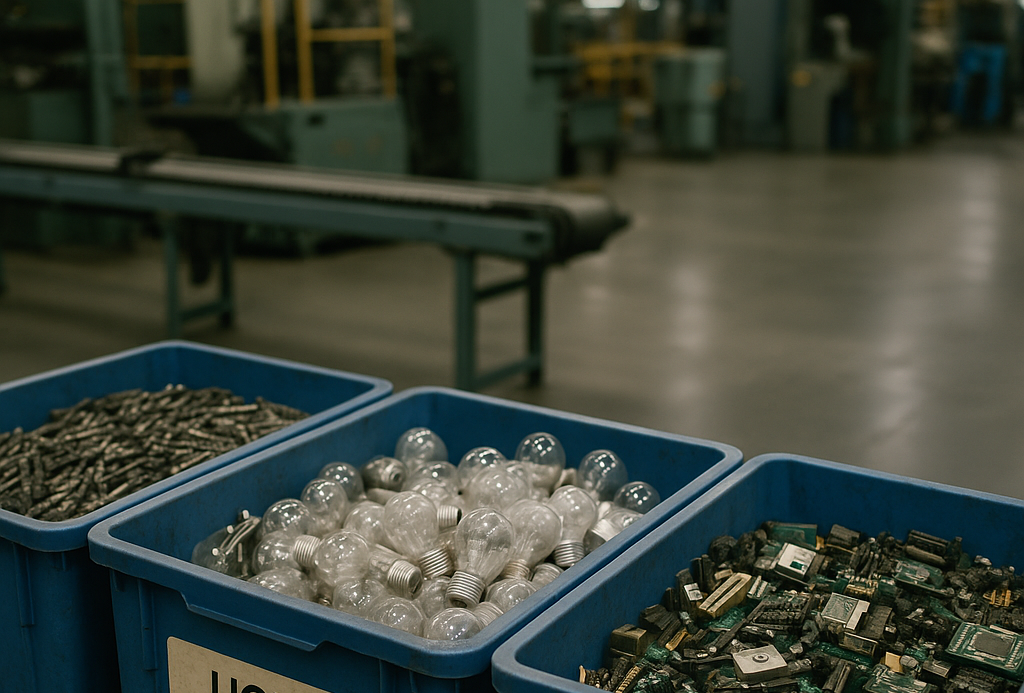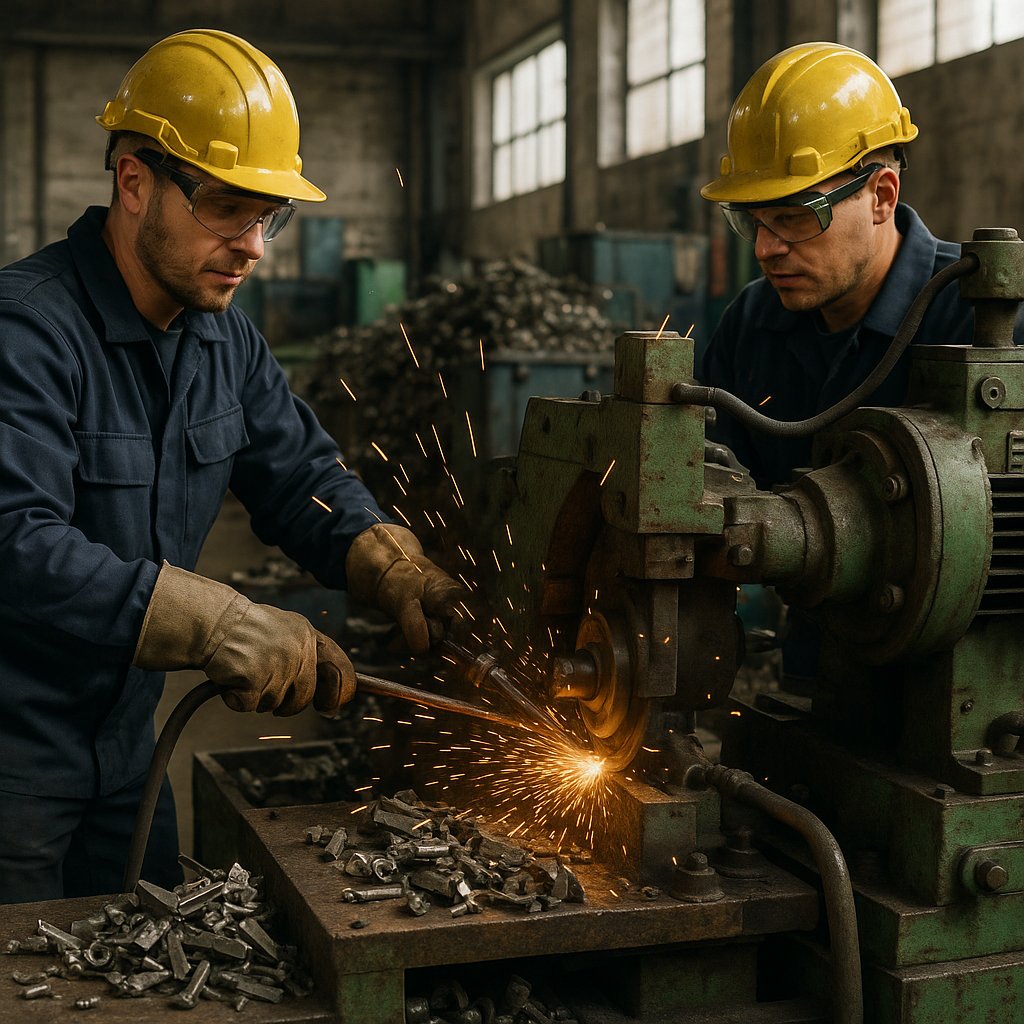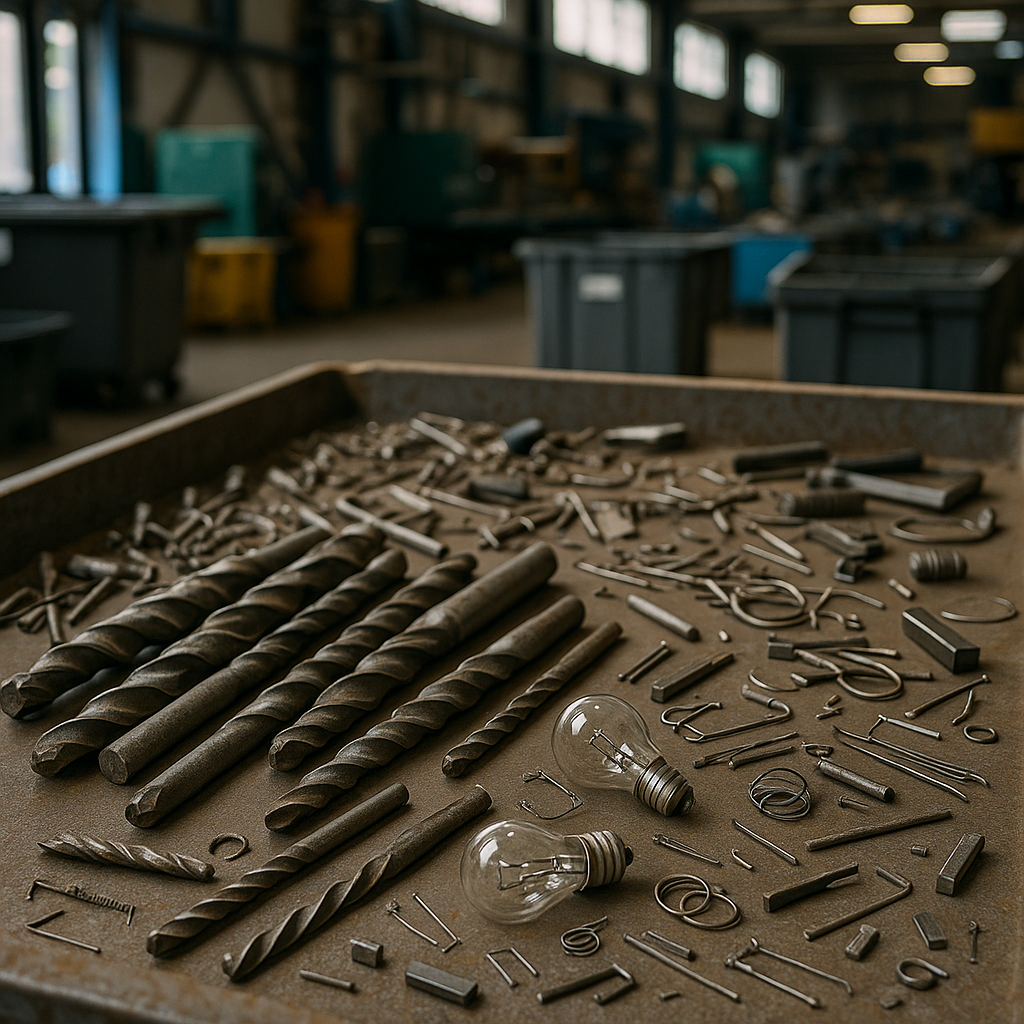5901 Botham Jean Blvd, Dallas, TX 75215
What Is Tungsten Recycling and Why Is It Important?
September 28, 2025Did you know that less than 10 percent of the world’s tungsten reserves are found in the United States? This scarcity makes tungsten recycling not just beneficial but essential for sustainable industrial operations. Tungsten recycling involves the recovery and reprocessing of tungsten from scrap and waste materials to create new products with the same quality as those made from virgin materials.
Tungsten is often called a ‘critical mineral‘ due to its exceptional properties and limited availability. It has the highest melting point of all metals, remarkable hardness, and excellent wear resistance. These properties make it invaluable for applications ranging from cutting tools and mining equipment to electronics and medical devices.
The importance of tungsten recycling extends beyond resource conservation. Currently, about 30% of the global tungsten supply comes from recycled sources, significantly reducing the need for new mining operations. This recycling effort decreases energy consumption, minimizes waste in landfills, and helps maintain price stability in an often volatile market. For industries dependent on tungsten components, recycling provides a sustainable path forward in a world of finite resources.
What Are the Main Sources of Recyclable Tungsten?

Tungsten carbide scrap represents one of the most valuable and abundant sources of recyclable tungsten in today’s industrial ecosystem. This material primarily comes from the machining and metalworking industries, where carbide tools eventually reach the end of their service life but retain their valuable tungsten content.
Machine shops generate significant quantities of recyclable tungsten through worn cutting tools. These include carbide inserts, end mills, drill bits, reamers, and boring tools. The high concentration of tungsten in these items makes them particularly valuable for recycling programs. Many shops unknowingly discard these items, missing potential revenue opportunities.
Mining operations contribute substantially to the tungsten recycling stream through worn drill bits and mining compacts. These components face extreme conditions and wear, but their tungsten content remains recoverable even after their functional life ends. The mining industry’s scale means these sources generate significant recyclable material annually.
Manufacturing and Production Scrap
Production facilities create various forms of tungsten scrap during manufacturing processes. This includes grinding sludge, powders, and turnings that contain recoverable tungsten. Even the steel roll scrap produced during tungsten processing represents a viable recycling opportunity.
Manufacturing waste streams often contain what’s known as “soft scrap” – tungsten-bearing materials like powders, grindings, and sludges. While these require different processing methods than solid scrap, they contain significant tungsten content. Proper collection systems in production facilities can capture this valuable material instead of allowing it to enter general waste streams.
Rejected parts and quality control failures also contribute to the recyclable tungsten supply. Components that don’t meet specifications still contain valuable tungsten that can be recovered through appropriate recycling channels.
Consumer and Commercial Products
Beyond industrial sources, numerous consumer and commercial products contain recyclable tungsten. Ballpoint pen tips utilize tungsten carbide for durability. Jewelry, particularly tungsten carbide rings, represents a growing source of recyclable material as fashion trends change.
Electrical applications provide another source of recyclable tungsten. Filaments in lighting, electrical contacts, and heat sinks all utilize tungsten for its exceptional properties. When these devices reach end-of-life, their tungsten components can be recovered.
The military and aerospace sectors generate tungsten scrap through various components. Counterweights in aircraft, armor-piercing ammunition, and missile components all utilize tungsten alloys that can be recycled when these systems are decommissioned or upgraded.
Heavy Metal Alloys and Specialized Applications
Tungsten heavy metal alloys represent another significant recycling opportunity. These alloys, typically composed of tungsten with nickel, iron, or copper binders, appear in radiation shielding, counterweights, and vibration dampening applications. Their high density makes them ideal for specialized uses but also valuable for recycling.
Medical equipment, particularly surgical instruments and radiation shielding components, contains recoverable tungsten. The healthcare industry’s strict replacement schedules for critical equipment ensures a steady stream of these recyclable materials.
Sports equipment manufacturers use tungsten in products requiring weight with minimal size. Golf club weights, dart barrels, and fishing sinkers all contain tungsten that can be recovered when these items are discarded.
The diverse applications for tungsten create multiple streams of recyclable material across industrial, commercial, and consumer sectors. Organizations implementing tungsten recycling programs should consider all potential sources to maximize recovery rates and sustainability benefits.
What Are the Main Tungsten Recycling Methods?

The recycling of tungsten materials involves three distinct approaches, each suited to different types of scrap and desired outcomes. These methods have evolved over decades to maximize recovery while balancing economic and environmental considerations.
Direct Recycling: Preserving Material Composition
Direct recycling transforms tungsten scrap into powder with the same composition as the original material. This approach works particularly well for clean, well-sorted scrap of known composition. The zinc process stands as the most widely used direct recycling method in the industry today.
In the zinc process, carefully sorted tungsten carbide scrap is exposed to liquid zinc at temperatures between 600°C and 900°C. The zinc reacts with the binder material (typically cobalt), causing the scrap to expand and become brittle. After vacuum distillation removes the zinc, the material can be easily crushed into powder ready for reuse. This method requires minimal energy—approximately one-third of what’s needed to produce virgin tungsten carbide—and generates little chemical waste.
Think of direct recycling like restoring a vintage car without replacing any original parts. You’re keeping everything intact, just rearranging the components for renewed functionality. The key requirements include high-purity input materials and proper sorting, as any contamination directly affects the quality of the recycled product.
Chemical Recycling: Complete Transformation
Chemical recycling, also called indirect recycling, converts tungsten scrap into pure intermediate compounds like ammonium paratungstate (APT), which then serve as raw materials for producing various tungsten products. This method can handle virtually any tungsten-containing scrap, including mixed or contaminated materials.
The process typically begins with oxidizing the scrap in air at temperatures between 800°C and 900°C to convert tungsten into water-soluble compounds. These compounds are then extracted through alkaline digestion under controlled conditions, followed by purification steps similar to those used for processing primary tungsten ore.
Chemical recycling is like completely melting down and refining gold jewelry to create pure gold that can be fashioned into any new design. While it requires more energy and chemicals than direct methods, it produces materials with “virgin” properties, meaning recycled tungsten from this process performs identically to tungsten derived from ore. This approach also allows for the recovery of valuable by-products like cobalt, nickel, and tantalum.
Semi-Direct Recycling: Selective Component Recovery
Semi-direct recycling offers a middle ground between the other methods. It selectively dissolves certain components of the tungsten scrap while leaving others intact. For instance, when recycling tungsten carbide tools, acid leaching can dissolve the cobalt binder while preserving the tungsten carbide structure.
This approach is comparable to salvaging the expensive engine parts from a car while replacing the body. The tungsten carbide particles remain unaltered, maintaining their original shape and properties, while the binder material is removed and recovered separately. The process typically uses acids or occasionally alkaline solutions to dissolve the binder metal.
Semi-direct methods require fewer chemicals and less energy than chemical recycling but can handle a wider variety of scrap than direct methods. However, they tend to progress more slowly, making them better suited for specialized applications rather than high-volume processing.
Choosing the Right Method for Specific Scrap Types
The selection of a recycling method depends on several factors. Clean, sorted tungsten carbide inserts from cutting tools are ideal candidates for direct recycling. Mixed or contaminated scrap typically requires chemical recycling. Semi-direct methods work well for complex composite materials where preserving the tungsten carbide structure offers economic advantages.
The growing importance of tungsten recycling has driven continuous improvements in these technologies. Modern facilities often combine multiple approaches to maximize recovery rates and economic returns while minimizing environmental impact. As recycling technologies advance, the industry moves closer to creating a truly circular economy for this valuable metal.
Each recycling method has emerged to address specific challenges in reclaiming tungsten from different waste streams. Together, they form a comprehensive system that allows approximately 35% of global tungsten supply to come from recycled sources, with potential for significant expansion as collection systems improve and recycling technologies advance.
What Are the Economic and Environmental Benefits of Tungsten Recycling?
Tungsten recycling creates a dual advantage for businesses and our planet. Companies that implement effective recycling programs reduce their dependence on primary tungsten sources while simultaneously contributing to environmental conservation. The economic and ecological benefits work together to create a compelling case for tungsten recovery.
Economic Advantages
The financial benefits of tungsten recycling are substantial and multifaceted. Companies engaging in tungsten recycling can realize significant cost savings while protecting themselves from market volatility.
Recycled tungsten typically costs 20-30% less than virgin tungsten, making it an economically sound choice for manufacturers. This price differential stems from lower production costs, as recycling requires approximately 60-80% less energy than primary extraction.
Recyclers typically pay between $5-10 per pound for tungsten carbide scrap, creating a revenue stream from what would otherwise be waste material. For companies that use large quantities of tungsten-based tools, this recovery value can substantially offset operational costs.
- Reduced production costs compared to mining and refining virgin tungsten
- Insulation from price fluctuations in primary tungsten markets
- Additional revenue stream from selling scrap material
- Lower operational costs for businesses that incorporate recycled tungsten
- Decreased dependency on geopolitically sensitive supply chains
The zinc-reclamation process, one of the most efficient recycling methods for tungsten carbide, further enhances these economic benefits by preserving the valuable carbide structure while consuming only about 4kWh/kg of energy, compared to 12kWh/kg for virgin tungsten carbide production.
Environmental Benefits
The environmental advantages of tungsten recycling are equally compelling. By reducing the need for primary mining, recycling significantly decreases the ecological footprint of tungsten products.
Tungsten mining requires substantial land disruption, with potential impacts including deforestation, habitat destruction, and water pollution. Recycling helps mitigate these effects by reducing demand for newly extracted material.
Energy consumption represents another critical environmental factor. The recycling process typically requires 60-80% less energy than primary production, resulting in substantially lower carbon emissions.
- Minimized land disruption from reduced mining activity
- Decreased water usage and pollution compared to primary extraction
- Significant reduction in energy consumption and associated CO2 emissions
- Conservation of a finite resource with strategic importance
- Reduced waste material sent to landfills
Approximately 30% of the global tungsten supply currently comes from recycled sources, helping to substantially reduce the carbon footprint associated with tungsten-based industries.
Sustainability Integration
Many forward-thinking companies have integrated tungsten recycling into their broader sustainability initiatives. This integration provides benefits beyond immediate cost savings, enhancing corporate image and meeting growing stakeholder expectations for environmental responsibility.
Companies across aerospace, energy, and manufacturing sectors have established tungsten recovery programs that divert material from landfills while securing more stable supply chains. These initiatives often become centerpieces of corporate sustainability reporting.
Regulatory frameworks increasingly favor recycling practices. In some regions, financial incentives or tax benefits are available to businesses that prioritize recycled materials, further enhancing the economic case for tungsten recycling.
The quality of recycled tungsten has improved significantly with technological advances. Modern recycling processes can produce material that meets or exceeds the specifications of virgin tungsten for many applications, removing a traditional barrier to adoption.
For companies implementing sustainability initiatives, tungsten recycling represents a concrete, measurable action with quantifiable environmental benefits that can be reported to stakeholders and customers who increasingly value ecological responsibility.
Conclusion

Tungsten’s unique properties and limited reserves make recycling essential for both industry and the environment. By recovering valuable material from industrial scrap, consumer products, and specialized equipment, businesses can cut costs, reduce their ecological footprint, and secure a more stable supply chain. Choosing to recycle tungsten isn’t just about resource efficiency—it’s a commitment to sustainability and long-term value.
For your metal recycling needs, contact Okon Recycling at 214-717-4083. Partner with us to turn your scrap into sustainable solutions.
